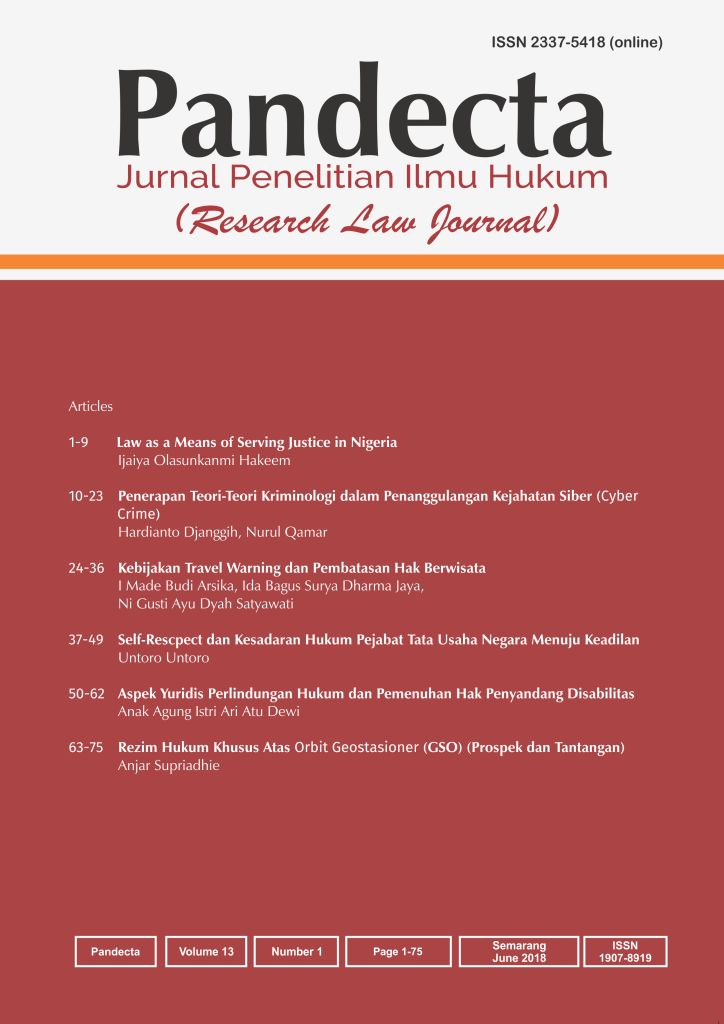Formulating Institutional Harmonization of UNNES Legal Entity Organs in The Frame of Check and Balances System
(1) Faculty of Law, Universitas Negeri Semarang, Indonesia
(2) Faculty of Law, Universitas Negeri Semarang, Indonesia
(3) Faculty of Islamic Economic and Business, Universitas Islam Negeri Walisongo, Indonesia
Abstract
As a dynamic organization, Universitas Negeri Semarang (UNNES) continues to improve itself towards better public services, namely as a State University Legal Entity. State University Legal Entities have a very positive impact, especially the autonomy of academic and non-academic administration and management. After drafting the statutes and forming the organs of the UNNES, the institutions that need to be prepared are institutional arrangements so that the harmony of the organs of UNNES is maintained as a State University Legal Entity. In order to be organized and harmonious relations occur, in line between the organs of the UNNES as a state university legal entity, a check and balances system needs to be implemented. The application of checks and balances system between organs of State Universities Legal entities, UNNES needs to be covered in a regulation so that there will be no mutual claims and shows of strength. Based on this background, this research is based on the formulation of the problem, what is the format of the check and balances system of relations between organs of State University Legal Entities, UNNES in order to achieve the vision and mission as formulated in the statutes? And what is the appropriate formulation/draft so that there can be harmonization of relations between the organs of UNNES, State Universities Legal Entities? Based on the formulation of the problem, it is intended to produce a harmonious relationship format between organs of State Universities Legal Entities, UNNES, as well as produce appropriate regulations in maintaining harmonization of relations between organs of UNNES as a State Universities Legal Entity. Based on the research objectives, the suitable research method used is qualitative research with a policy approach. The research object is using deep interview and document analysis methods.
Keywords
Full Text:
PDFReferences
Ahmad Darlis, M. Ariandi Lubis, Mazidatul Farha, Rizka Rahmi Putri Laoli, Sri Indah Lestari, “Perguruan Tinggi Berbadan Hukum (PTN-BH),” Humantech: Jurnal Ilmiah Multidisiplin Indonesia 2, no. 3 (Januari, 2023): 585, https://doi.org/10.32670/ht.v2i3.2921.
Aqil Irham, “Demokrasi Tanpa Korupsi, Mungkinkah?,” Jurnal TAPIs 14, no. 1 (Januari-Juni, 2017): 99, https://doi.org/10.24042/tps.v13i1.1936.
Barda Nawawi Arief, “Penelitian Hukum Normatif (Suatu Upaya Reorientasi Pemahaman)” (Makalah disajikan pada Penataran Metodologi Penelitian Hukum, Universitas Jenderal Soedirman, Purwokerto, 11 - 15 September 1995), 6.
Creswell, J., W., Research Design: qualitative, quantitative, and mixed methods approaches – 4th ed. (California: SAGE Publications, Inc).
Fajar ND, Mukti dan Yulianto Ahmad, Dualisme Penelitian Hukum Normatif dan Empiris, (Yogyakarta: Pustaka Pelajar, 2010), 113.
Habibul Umam Taqiuddin, “Hermeneutika Hukum Sebagai Teori Penemuan Hukum Baru,” Jurnal Ilmiah Mandala Education (JIME) 2, no. 2 (Oktober 2016): 326, http://dx.doi.org/10.58258/jime.v2i2.347.
Manotar Tampubolon, Abdul Hamid, Mia Amalia, Herniati, Mahrida, Fahmi Assulthoni, Geofani Milthree, Zuhdi Arman, Sosiologi Hukum (Koto Tangah: PT. Global Eksekutif Teknologi, 2023), 1-11.
Odang Suparman, “Konsep Lembaga Negara Indonesia dalam Perspektif Teori Trias Politica Berdasarkan Prinsip Checks and Balances System,” AHKAM: Jurnal Hukum Islam dan Humaniora 2, no. 1 (Maret, 2023): 59-75, https://doi.org/10.58578/ahkam .v2i1.
Refbacks
- There are currently no refbacks.


